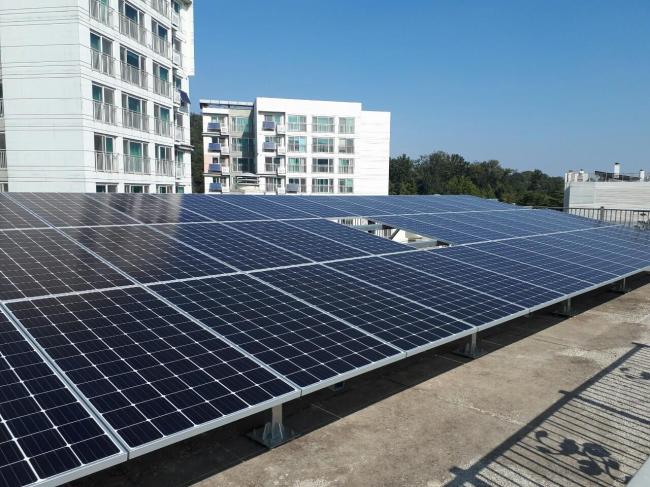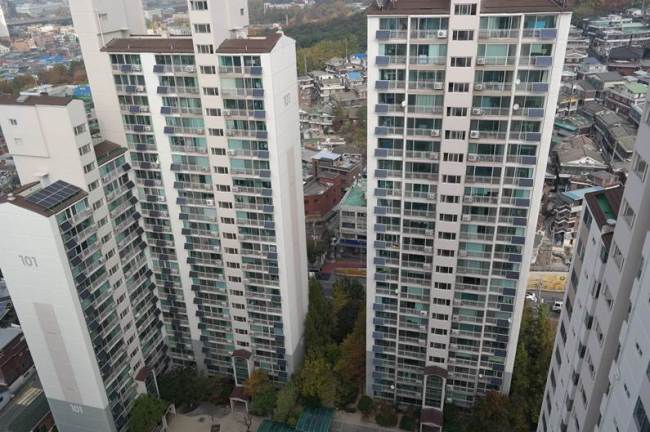Renewable energy accounts for only about 6 percent of the total electricity generated in Seoul, while residents living in apartments pay higher maintenance fees -- including electricity bills for shared spaces -- than those living outside of South Korea’s capital.
However, things are slowly changing thanks to the Seoul Metropolitan Government’s efforts to tackle the heavy reliance on coal and nuclear energy. Over the past few years, many apartment complexes in the capital have started using solar panels and light-emitting diode lighting, which allows them to cut down a significant amount of their monthly maintenance fees.
 |
A solar panel is installed at the rooftop of Sinjeong Ipen House, one of the 100 “energy self-sufficient villages” in Seoul, designated apartment complexes where residents use renewable energy technologies. (Seoul Metropolitan Government) |
According to the Seoul Metropolitan Government, Seoul residents who live in apartment complexes pay monthly maintenance fees that are approximately 11 percent higher than the national average, mainly because there are more high-rise residential buildings in Seoul, and many of them have large parking lots in the basement -- which often lead to high electricity bills for shared spaces.
But for residents in Hongneung Donbu Apartment, an apartment complex in Seoul’s Dongdaemun district, solar panels have significantly reduced their maintenance expenses.
Hongneung Dongbu is one of some 100 “energy self-sufficient villages” in Seoul, designated apartment complexes or housing communities where residents use renewable energy technologies, including solar panels, with financial support from the Seoul Metropolitan Government.
For the first time in the country, the apartment complex last year installed small-sized solar panels in almost every unit in the property. As of July this year, 360 of its 371 units have installed solar panels -- devices that convert light into electricity.
The apartment complex also replaced all of the incandescent bulbs used in its parking lot, elevators and other shared spaces, with LED bulbs, which use between 80 to 85 percent less energy than traditional bulbs.
 |
Hongneung Donbu Apartment, an apartment complex in Seoul’s Dongdaemun district where residents use solar panels to reduce electric bills. (Seoul Metropolitan Government) |
Previously considered expensive niche products, LED bulbs are now becoming an affordable choice for Koreans looking to reduce their electric bills. Unlike incandescent bulbs, LED lighting generates more light than heat, and lasts as much as 25 times longer.
As a result, the residents at Hongneung Dongbu together were able to save on some 36 million won ($31,933) won worth of maintenance fees from March to December last year.
Another apartment complex in Seoul, Hwigyeong Hyundai Best-ville Apartment, also installed solar panels in all of its 372 units this year.
South Korea last year finalized a power supply plan that aims to meet 20 percent of its total electricity consumption with renewable sources by 2030. The country currently generates some 70 percent of its power from nuclear and coal.
“I can say that the way people can save on maintenance fees by saving energy has proven to be effective,’ said Kim Yeon-ji, an official at the energy division at the Seoul Metropolitan Government.
“A significant number of Seoul residents live in apartment complexes. We hope to see all apartment complexes in the city participating in energy-saving strategies eventually.”
The Seoul Metropolitan Government also runs a consulting service through which energy experts visit apartment complexes where residents are interested in reducing their shared electric bills -- thereby saving on their maintenance fees -- by using LED bulbs as well as solar panels.
Through the consulting service, residents in an apartment complex in Seoul’s Seongbuk district learned that the incandescent bulbs in the parking lot had been the reason behind their unusually high electric bills. They also found out that if they replaced the existing bulbs with LED bulbs, they could save on up to 98 million won ($86,717) worth of maintenance fees a year.
In the US, switching entirely to LED lights over the next 20 years could save the country $250 billion in energy costs and avoid 1,800 million metric tons of carbon pollution. The Seoul Metropolitan Government has been making efforts to encourage Seoul citizens to switch to LED lighting from traditional incandescent bulbs.
Those interested in using renewable energy technologies supported by the Seoul Metropolitan Government can call (02) 2133-3662.
By Claire Lee (
dyc@heraldcorp.com)









![[Today’s K-pop] Blackpink’s Jennie, Lisa invited to Coachella as solo acts](http://res.heraldm.com/phpwas/restmb_idxmake.php?idx=644&simg=/content/image/2024/11/21/20241121050099_0.jpg)